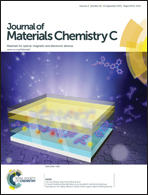Bimodal silicone interpenetrating networks sequentially built as electroactive dielectric elastomers†
Abstract
Two polysiloxanes, a polydimethylsiloxane-α,ω-diol (PDMS) with Mn = 370 000 g mol−1, and α,ω-bis(vinyl)polydimethylsiloxane (Vi2PDMS) with Mn = 34 500 g mol−1, and appropriate crosslinking systems for each of them (tetraethyl orthosilicate–dibutyltindilaurate and α,ω-bis(trimethylsiloxy)poly(dimethylmethyl-H-siloxane)–Speier's catalyst, respectively), were mixed together in various weight ratios (1 : 0.1, 1 : 0.2, 1 : 0.3, 1 : 0.5) and cast into films. These were sequentially crosslinked by different mechanisms. A determined pre-stretch was applied to the first network after its formation followed by thermal treatment for curing the second network. Non-prestreched networks were also prepared in parallel for comparison. The aged films were characterized from the point of view of the soluble fraction content, and analysed by differential scanning calorimetry, water vapour sorption in dynamic regime, dielectric spectroscopy and tensile tests. Dielectric strength and actuation strain were measured to estimate the suitability of the samples for electromechanical applications. The results revealed that through this approach one can relatively easily obtain very simple and homogeneous materials suitable for use as dielectric elastomer transducers.


 Please wait while we load your content...
Please wait while we load your content...